If you’re an admirer of native flowering plants and you’re looking at establishing a low-maintenance and ornamental addition in your garden, the stunning Dianella revoluta is certainly worth considering.
This plant is widely distributed across Australia and can grow in extremely variable conditions. It features an attractive form, deep-blue to violet flowers and highly decorative edible fruits.
Here is your full guide to growing and caring for Dianella revoluta.
More...
Genus: | Dianella |
|---|---|
Species: | D. revoluta |
Family: | Asphodelaceae |
Common Names: | Blueberry lily, Blue flax lily, Black anther flax lily |
Location: | Outdoor |
Type: | Flowering plant, Grass-like perennial herb |
Growth: | 1 metre tall, 1.5 metres wide |
Sun requirements: | Full sun to full shade |
Foliage Colour: | Green |
Flower Colour: | Blue to violet |
Flowering: | Spring to summer |
Fruit: | Edible purple berries in late summer |
Maintenance level: | Low |
Poisonous for pets: | Non-toxic to cats and dogs |
Introducing Dianella revoluta
Also known as blueberry lily, blue flax-lily or black-anther flax-lily, this plant is endemic to Australia where it thrives in many different conditions across the country, except for the Northern Territory.
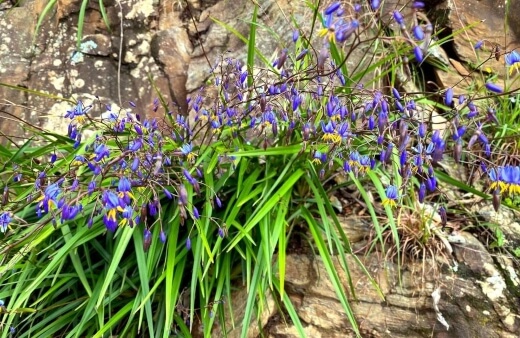
It is a part of the Asphodelaceae family (subfamily Hemerocallidaceae), traditionally being used for its edible fruits and strappy, leathery leaves that were made into cord and string.
See our full guide on Dianella and its most popular species in Australia.
It is slow-growing, usually reaching about 1 metre tall and 1.5 metres wide in cultivation. It has a clump-like growth habit that grows from rhizomes underground and unique small flowers that sit at the tips of wiry stems above the tufted foliage.
These plants look best in ornamental mass plantings, rock gardens, container gardens, narrow spaces or as textured understory in and around large trees in your landscape.
Once established, Dianella revoluta is frost and drought tolerant. It will attract birds, bees (get to know more about Australian native bees) and insects and fruit from year one.
Blueberry Lily Plant Features
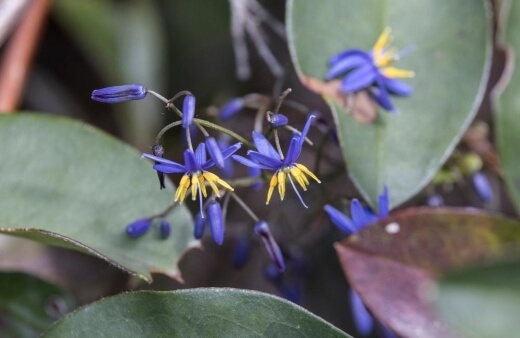
The Dianella genus has become an extremely popular choice for modern domestic gardens and these plants are widespread throughout temperate and subtropical suburbia in Australia.
This erect perennial herb features grass-like blueish-grey foliage with delicate purple flowers that bloom for long periods, meaning this plant can decorate your garden for a long time with its attractive fruits, flowers and compact evergreen foliage.
Once established, it’s extremely hardy and thanks to its form, it can serve many applications within your landscape.
Popular Dianella Species to Grow in Australia
Blue Flax Lily (Dianella caerulea)Also known as Paroo lily, this plant is widespread throughout Tasmania, Victoria, NSW and Queensland. It grows to about 1 metre and features dark green blade-like leaves, blue flowers and indigo-coloured berries. Popular cultivars include Little Jess, King Alfred and Emerald Fountain. | 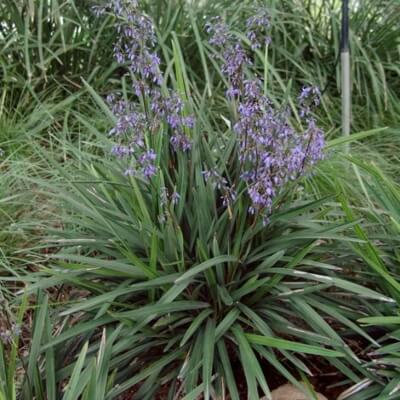 Source: plantsexpress.com |
Tasman Flax Lily (Dianella tasmanica)Known as Tasman flax-lily, this variety is more tolerant to shade, moisture and cooler temperatures. It grows very well in coastal regions and normally reaches up to 2 metres tall. Unlike other dianellas, this variety's fruit is toxic. Popular cultivars include Silver Streak, Cherry Red, Blaze and Destiny. |  Source: andreasensgreen.com.au |
Blueberry Lily (Dianella revoluta)This is one of the most popular varieties featuring unique rolled-back leaves that curl. Popular cultivars include Little Rev and Prestige. |  Source: heritagenursery.com.au |
Native Flax (Dianella prunina)One of the lesser spread varieties, this plant features more colourful foliage and a spreading growth habit. Popular cultivars include Utopia and Rainbow Twist. | 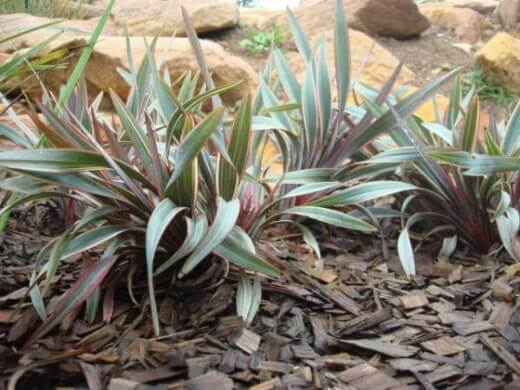 Source: homedesigndirectory.com.au |
Blue Flax Lily (Dianella caerulea)

Source: plantsexpress.com
Also known as Paroo lily, this plant is widespread throughout Tasmania, Victoria, NSW and Queensland. It grows to about 1 metre and features dark green blade-like leaves, blue flowers and indigo-coloured berries.


Get Your Free Guide:
Master Growing Australian Natives eBook
A Must Have Complete Guide for Every Australian Garden
Get Your Free Guide:
Master Growing Australian Natives eBook
A Must Have Complete Guide for Every Australian Garden
Popular cultivars include Little Jess, King Alfred and Emerald Fountain.
Tasman Flax Lily (Dianella tasmanica)

Source: andreasensgreen.com.au
Known as Tasman flax-lily, this variety is more tolerant to shade, moisture and cooler temperatures. It grows very well in coastal regions and normally reaches up to 2 metres tall.
Unlike other dianellas, this variety's fruit is toxic. Popular cultivars include Silver Streak, Cherry Red, Blaze and Destiny.
Blueberry Lily (Dianella revoluta)

Source: heritagenursery.com.au
This is one of the most popular varieties featuring unique rolled-back leaves that curl. Popular cultivars include Little Rev and Prestige.
Native Flax (Dianella prunina)

Source: homedesigndirectory.com.au
One of the lesser spread varieties, this plant features more colourful foliage and a spreading growth habit. Popular cultivars include Utopia and Rainbow Twist.
How to Grow Dianella revoluta
These plants can be grown from ripe seeds collected from fruits and sown in spring. Alternatively, propagated through division of the rhizomes struck in moist, shady conditions and planted into light soil in the cooler months around late winter.
Lastly, young and healthy plants are readily available from local nurseries or online retailers.

Source: cocreative.co.nz
Growing Black Anther Flax Lily from Seed
Seeds are ready for harvest once the berries have turned fully blue and the flesh is soft and squishy which is normally around late summer to early autumn.
Each berry should contain about 3 to 4 hard, black seeds which you can extract and use.
- Prepare small pots or containers with high-quality potting mix.
- Place the seeds on top of the mix, being careful not to cover them. They only need to be very lightly covered to avoid rotting before germination.
- Water the seeds afterwards and place them in a warm and humid location away from bright, direct light and strong winds.
- Try to avoid watering after the initial watering unless the soil dries out.
- Dianellas strike quickly from seed so you should already see the first shoots emerge within only a few weeks.
- Thereafter, leave the seedlings to develop for another 3 to 4 months, watering as needed.
- Now you should have healthy and established seedlings you can transplant.
Propagating Blueberry Lily by Division of Rhizomes
Most grass-like plants grown from rhizomes can easily be divided and propagated. The division of your Dianella revoluta should be done in autumn so the divided plants can establish themselves in the cooler, shadier conditions in winter.
- Gently remove your plant from the ground or pot, being careful not to cut into or damage the root system.
- Using a sharp and clean spade or shovel, cut and divide the rhizomes into separate clumps. Depending on the size of the plant, you can cut it into 2 to 3 separate clumps, each with a healthy number of leaves and other foliage.
- Prepare containers or your garden bed with enriched, well-draining light soil and a little compost.
- Plant each divided plant into a dug-out hole and backfill with soil.
- Water well after planting and keep the soil moist as the plant establishes new growth and roots.
Planting Dianella revoluta
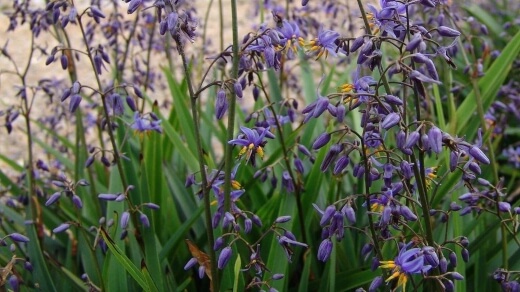
Source: cocreative.co.nz
This herbaceous plant is very well adapted to our endemic conditions so it can grow and thrive in a wide range of moisture conditions and temperature ranges.
They require very basic growing conditions to live happy and healthy lives. Here are the ideal planting and growing conditions for Dianella revoluta.
Best Lighting Conditions
It is suitable for full sun positions, partial shade or even fully shaded positions in the garden or outdoors. Fruiting and flowering may be slightly diminished in more shaded locations but the plant will be able to grow.
Ideal Soil to Use
Dianella can grow in most soils but prefers well-draining soil enriched with organic materials like compost or blood and bone. Sandy soils tend to work great.
Caring for Blueberry Lily
These plants generally require very little maintenance and only basic care. Here are some quick care tips for your Dianella. Other than these few requirements, your plant won’t need anything else to thrive.
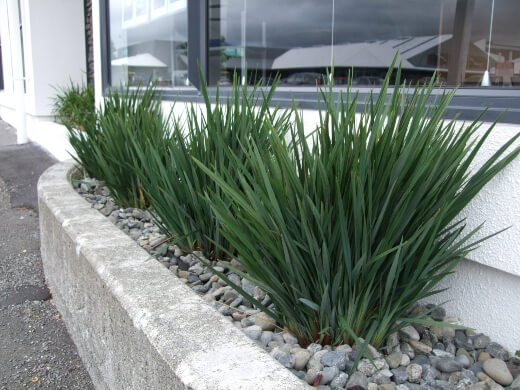
Source: andreasensgreen.com.au
Watering Blue Flax-Lily
When young, the plant will need lots of water to develop. After about the first year, you can substantially cut back on the water and only water supplementary as needed.
Fertilising Needs
In spring, feed with a slow-release fertiliser or comparable native fertiliser to encourage bountiful blooming and fruiting throughout spring and summer.
For more on fertilisers, refer to our Complete Garden Fertiliser Users Guide
Pruning Black-Anther Flax-Lily
In the winter months after flowering and fruiting, prune and cut back the plant lightly to remove dead and damaged brown leaves. This plant doesn’t require hard or frequent pruning.
Related: Pruning Australian Native Plants
Blueberry Lily Bush Tucker Guide
After flowering in summer, your Dianella revoluta will produce edible blue to purple berries with tiny, nutty seeds in them. The fruits are sweet, round and fleshy, ranging from 4 to 10 millimetres in diameter.
The entirety of the berries can be enjoyed fresh after rinsing or cooked into sweet or savoury dishes to add a fruity, nutty flavour profile to them. The plant root can also Dianella revoluta be pounded and roasted for eating.

Traditionally, these berries were used as an ingredient in teas for Aboriginal medicines. The root and leaves were used to help with colds and headaches, and the leaves were also used to make cords and string.
It is important to note that not all Dianella species produce berries that are safe for human consumption where some can be toxic like the berries from D. tasmanica, especially in large quantities.
This specific Dianella does produce palatable berries that are suitable for eating in moderation when ripe.
- There is very little research surrounding the nutrient content of these specific berries.
- Berries can be harvested by simply picking them from the branches of the plant.
- Berries can be stored in the fridge for about 2 weeks and in the freezer for up to 2 years.
Dianella revoluta Pests & Diseases
There are very few known pests and diseases that trouble these hardy natives. This is another reason why they are perfect for beginner growers.
One rare fungal disease your plant could contract is flax lily rust, which normally only affects plants in more coastal areas. It appears as a rusty colour on the leaves.
To treat this disease, cut down the plant to about 15cm above the ground and spray with a copper-based fungicide.
Dianella revoluta Frequently Asked Questions
Is Dianella a perennial or annual?
It is considered a perennial plant with sturdy foliage and a hardy attitude.
Why is my Dianella dying?
Dianellas are known to die back after a hard freeze. Simply cut away the leaves at the base of the plant and it will re-sprout as warmer temperatures return.
Are flax lilies invasive?
Only certain species are considered invasive. Dianella ensifolia is considered an invasive aggressive alien in many regions of the world.
Interested in growing other native plants? Be sure to check out our helpful guide on growing Australian native plants.
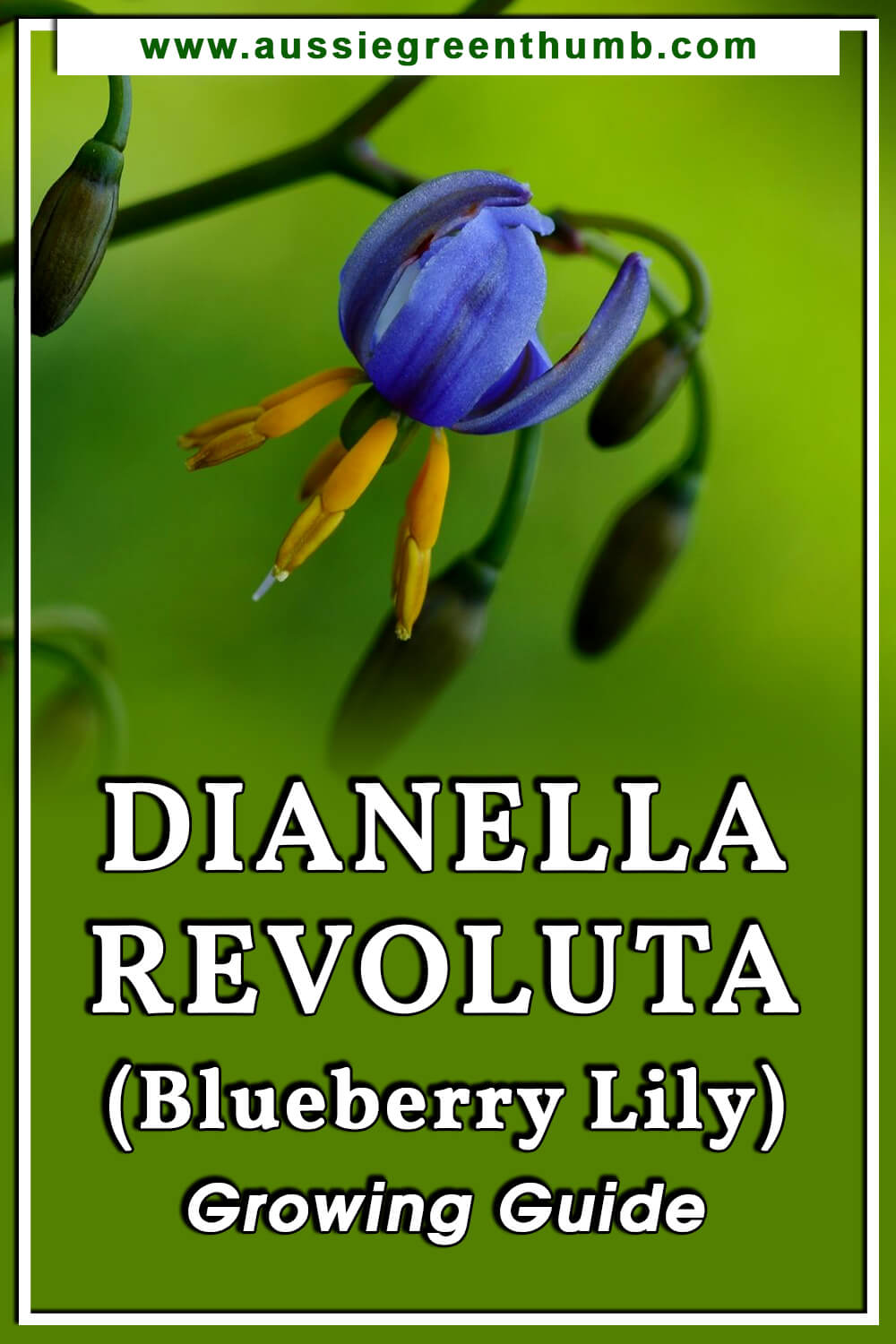
Start Growing Dianella revoluta Today
This all-around stunner is the perfect pick for anyone looking for an easy-going, ornamental native flowering plant that flowers for long periods and produces sweet, tasty fruits with many culinary applications.
Its attractive, clumping form allows growers to plant in masses where this plant can be used in many useful and decorative landscaping positions.
Being readily available in nurseries, easily grown from seeds or swiftly propagated using division, it's easy to see why Dianella revoluta has become so widespread across the country.
Published on June 18, 2022 by Nathan Schwartz
Last Updated on February 26, 2025




